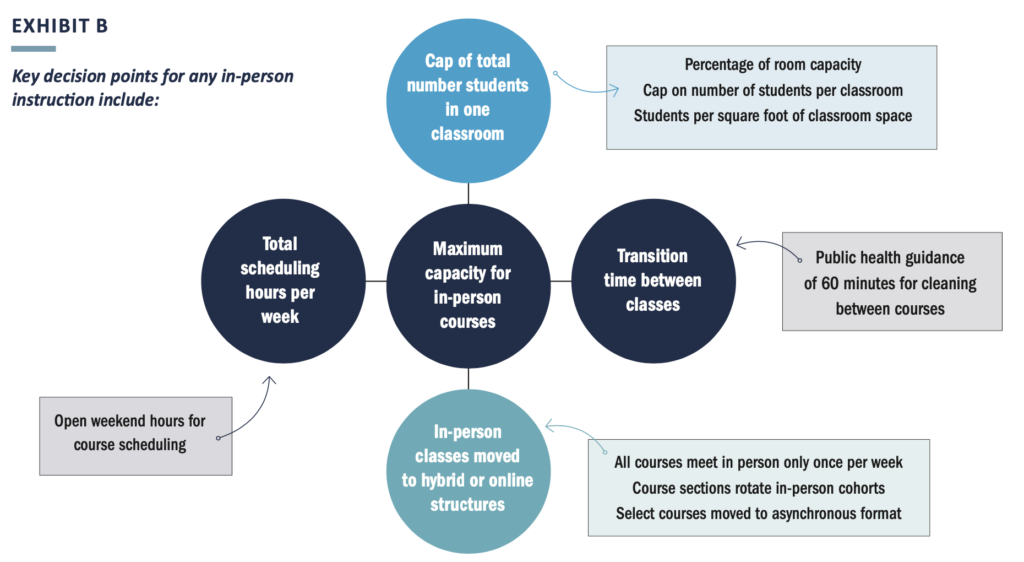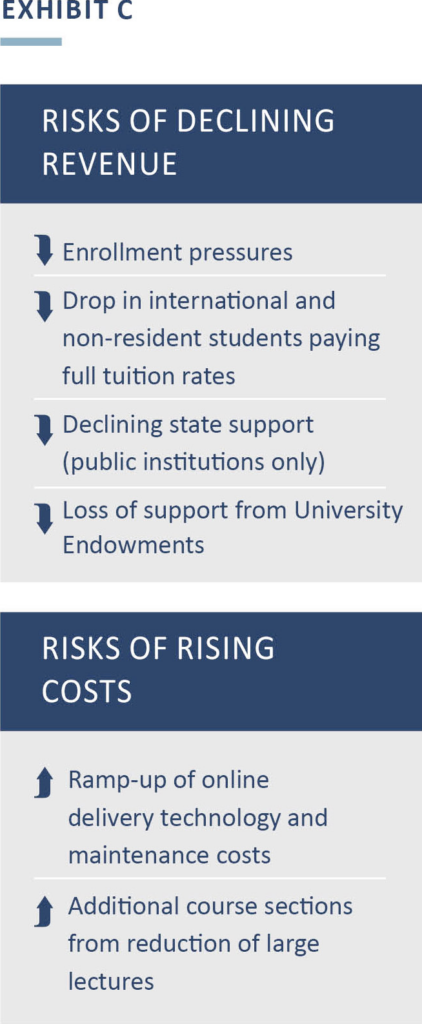As the reality of coronavirus and its impact on higher education has begun to set in, Kennedy & Company has been working closely with universities in helping them plan for the Fall 2020 term. Namely, we have been focused on how institutions and professional schools should plan for the upcoming academic year from an enrollment, financial, and logistical perspective. How can higher education leaders prepare for the Fall 2020 term when the outlook seemingly changes every day? Kennedy & Company has outlined three big questions that every higher education leader should be able to answer to effectively communicate with the campus population and coordinate its strategy and operations for the upcoming academic year.
1. How many students should we plan for next year in various public health scenarios?
Primary survey research conducted by Kennedy & Company shows continuing students are much more likely to return to campus if institutions offer in-person courses. However, these figures vary widely across institutions by their affordability, student body composition, academic reputation, location, and scalability to offer online courses.
Similar figures have been shown in various surveys for incoming students as well, meaning that higher education institutions have to balance the student demand for in-person classes while maintaining social distancing standards. Universities should be developing dynamic enrollment models based on various scenarios that predict how many students are likely to enroll via online and in-person pathways. Communication is key: institutions will be expected to provide an answer for its pedagogical delivery well in advance of Fall 2020 courses starting, which will have a major impact on enrollments for the upcoming term.

2. How can we deliver courses that meet student demand while abiding by public health standards?
While survey data shows that students are most likely to return if in-person courses are offered, how can universities offer in-person courses safely? Kennedy & Company has helped develop operational models for institutions to deliver courses to a diverse mix of undergraduate and graduate populations via online and in-person courses and across multiple campuses (if applicable). Key decision points for any in-person instruction include:

Institutions must also identify how to scale these in-person courses to limit costs. If seating capacity for in-person courses are severely constrained to meet public health standards, schools would need to offer many more course sections. However, sourcing additional faculty and paying for these resources is likely not an option for many institutions. Institutions need to identify strategies to leverage the in-person courses they offer, either through hybrid scheduling, simultaneous in-person and online instruction, or asynchronous course delivery. Each of these options has unique impacts on classroom space availability, budget, and technological resources.
3. What can we do to plan for the changing financial landscape during the upcoming year?
Institutions are faced with a cloudy financial picture for the upcoming fiscal year, with limited transparency into their overall financial picture in FY21 and beyond. Not only are many continuing students considering not returning during Fall 2020 but graduating high school students have expressed that they are much more likely to stay very close to home and either delay their entry into higher education for one year or attend online classes at local community colleges. Higher education institutions need to be prepared for how the enrollment picture will impact their total revenues and understand what level of support they can expect from their state or federal government.
Each of these scenarios puts pressures on costs, many of which are fixed and difficult for institutions to reduce quickly. Financial leaders have little insight into these risks right now, but as we progress into Summer 2020 additional data will help make the picture clearer. However, being prepared right now with up-to-date projections that factor in dozens of various scenarios and inputs can serve as a valuable planning and advocacy tool.

What can we do right now?
The best strategy for higher education leaders to pursue right now is to be ready for a range of possible outcomes and to share those outcomes with all institutional leaders. The universities that have most effectively planned for Fall 2020 and beyond are the ones with broad-based buy-in and support for developing projections and contingency plans around various enrollment, operations, and financial outcomes and understand the dynamic relationship between these three areas. As information on the spread of coronavirus becomes clearer in the Summer of 2020, these institutions will be able to quickly adapt their scenarios into coherent communication and action plans to educate students in a safe and responsible way in the Fall.
Want a PDF version of this whitepaper?
Click to download: Covid_Three_Questions_White_Paper (1)
If you would like to discuss how your institution is approaching any of these, or other, questions ahead of the Fall 2020 term, please contact Kennedy & Company’s consulting professionals.
Ben Kennedy
Sara Neher
Devon McGee
